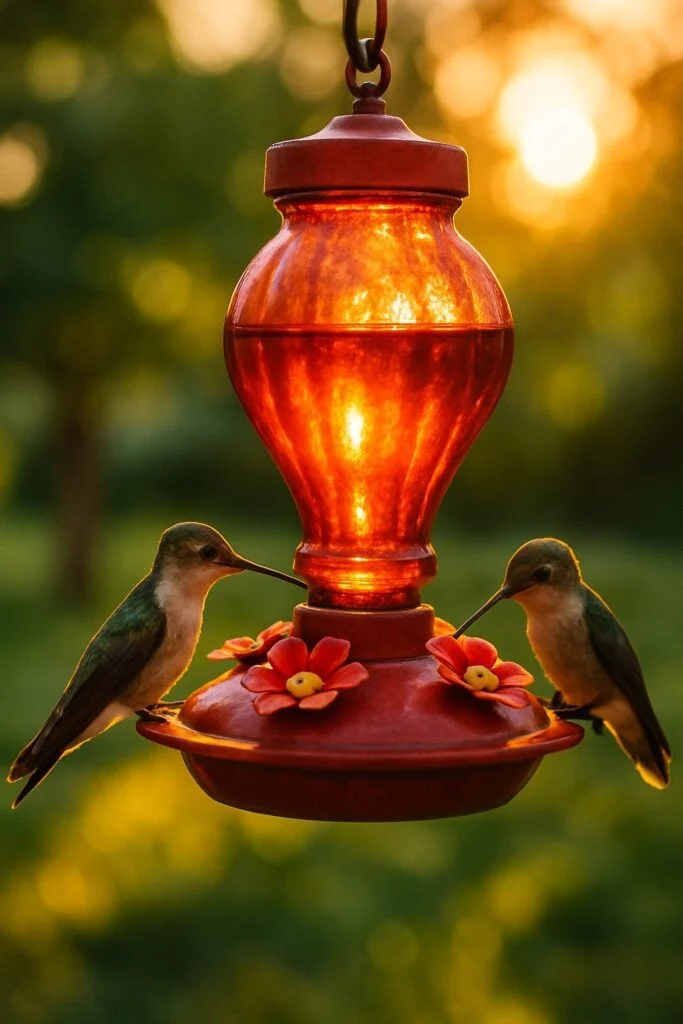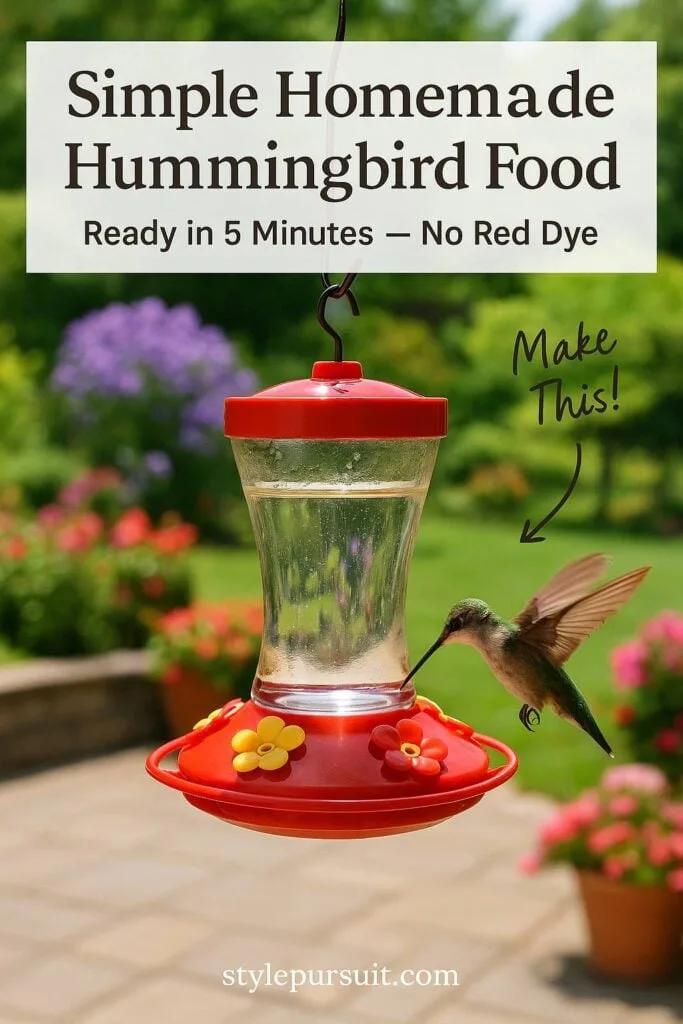Walk through the bird aisle of any garden center, and you’ll see rows of brightly colored bottles promising “nectar” in shades of cherry red and neon pink.
They look tempting, right? Like hummingbird Kool-Aid. But here’s the catch: those dyes aren’t necessary, and they might not be safe.
Hummingbirds are drawn to the color red itself, not to artificially dyed liquid. What they need is energy.
Plain, simple energy. Their bodies are built for high-speed living, hovering, darting, and sometimes migrating thousands of miles.
They don’t have time for fluff. The pure sugar in homemade nectar provides that fast fuel, and it does so without the questionable extras that often sneak into commercial mixes.
Another big reason homemade wins? Cost. That little bottle of “nectar” might set you back ten bucks, but with a five-pound bag of plain sugar, you can make weeks’ worth of hummingbird food for less than the price of a latte.
The choice seems obvious once you realize how little effort it takes.

The Classic Hummingbird Food Recipe
Here’s the recipe that works like a charm (and that ornithologists actually recommend):
- 1 part white granulated sugar
- 4 parts water
That’s it. Nothing fancy.
Step-by-step method:
- Bring the water to a boil. This isn’t just to dissolve sugar, it helps kill bacteria and keeps the mix fresher longer.
- Stir in the sugar until it disappears. No gritty bits allowed.
- Let it cool completely. (Hummingbirds may be tough little flyers, but hot sugar water isn’t safe for them.)
- Pour into a clean feeder, and watch the aerial show begin.
It feels almost too easy, but sometimes the simplest formulas really are the best. Just think of it like sweet tea for hummingbirds, light, refreshing, and exactly what they’re craving.
Why the 1:4 Ratio Matters
It’s tempting to think more sugar equals happier hummingbirds. After all, who doesn’t like an extra-sweet lemonade on a hot day?
But here’s the thing, too much sugar can actually harm them. Their tiny kidneys can’t process overly concentrated solutions, and dehydration becomes a real risk.
On the flip side, if the solution is too weak, they’ll sip and sip but won’t get enough calories to sustain their sky-high energy demands.
Imagine filling up your gas tank with watered-down fuel—it just doesn’t cut it.
That’s why the 1 part sugar to 4 parts water ratio is so widely recommended. It mirrors the average nectar concentration found in flowers.
It’s the “sweet spot” (literally) where they get enough calories without stressing their systems.
When you stick to this ratio, you’re giving them food that feels natural, not some weird lab experiment in a feeder.
Variations That Actually Work (and Some That Don’t)
Here’s where people love to get creative. You’ve probably seen blog posts or Pinterest hacks suggesting honey, brown sugar, or even agave syrup.
They sound wholesome, but when it comes to hummingbirds, not everything natural is good.
Things that are perfectly fine:
- Tap water: Totally okay unless your city water has heavy chlorine—if so, let it sit overnight to let chlorine evaporate.
- Filtered water: Works just as well.
- Storing nectar in the fridge: You can keep extra in a jar for up to a week, making refills quick and hassle-free.
Things that don’t work (and can actually harm them):
- Honey: It ferments fast, grows harmful bacteria, and can cause fungal infections in hummingbirds’ tongues.
- Brown sugar: Contains molasses, which their bodies aren’t designed to process.
- Artificial sweeteners: A total no-go. Zero calories means zero fuel, like offering an athlete a diet soda instead of water after a marathon.
If you stick to plain white sugar and water, you’ll be doing them a favor. No need to reinvent the wheel.
How Often Should You Change the Nectar?
Here’s the mistake that turns a good hummingbird setup into a no-show feeder: leaving the nectar sitting too long.
Sugar water isn’t shelf-stable once it’s outside. It ferments, molds, and attracts bacteria quickly, especially when the summer sun is blazing.
The general rule is simple:
- Cooler spring or fall days: Change every 4–5 days.
- Hot summer days (80–90°F and up): Change every 1–2 days. Sometimes daily if it’s really sweltering.
Think of it like leaving lemonade out on the counter. After a few days, it doesn’t taste fresh anymore, and hummingbirds can tell.
If the nectar spoils, not only will they skip your feeder, but they may stop visiting your yard altogether. Birds remember where they’ve had a bad experience.
A handy trick: make nectar in small batches and keep extra in mason jars in the fridge. That way, you can top off feeders without dragging out the sugar and saucepan every time.
The Feeder Makes a Difference
Even if you’ve got the recipe down, a leaky, hard-to-clean feeder can sabotage your efforts.
Hummingbirds are picky little visitors, if a feeder drips too much, grows mold inside, or attracts wasps, they’ll move on to the neighbor’s yard.
What makes a good feeder? A few things:
- Easy to clean – Wide-mouth jars are lifesavers. Narrow tubes are mold traps.
- No leaks – A steady drip means wasted nectar and ant invasions.
- Red accents – No need for red dye in the food itself. The feeder should provide the color.
Some popular feeders on Amazon that hummingbird lovers rave about:
- First Nature 32-ounce Hummingbird Feeder — Wide-mouth jar, super simple to clean.
- Aspects HummZinger HighView Feeder — Compact, sturdy, and dishwasher-safe.
- Perky-Pet Glass Hummingbird Feeder — Pretty enough to be garden décor, plus functional.
The right feeder makes life easier for you and more inviting for them. If you’re serious about keeping hummingbirds around, this is one area worth investing a little extra.
Keeping Feeders Clean (Yes, It Matters More Than You Think)
This part isn’t glamorous, but it’s probably the most important. A dirty feeder is like a dirty coffee pot, it ruins the taste and can actually make your guests sick.
For hummingbirds, the stakes are even higher.
Because they’re so tiny, just a little mold or bacteria can do real harm.
Here’s the deal: every time you change the nectar, you should clean the feeder. Not just a quick rinse, really clean it.
- Hot water rinse: Works for regular refills.
- Mild vinegar solution (1 part vinegar, 2 parts water): Perfect for deeper cleaning, especially if you see mold spots.
- Avoid soap residue: If you use dish soap, rinse until there’s absolutely no suds left.
And don’t forget the little crevices. Those feeding ports can get gunky fast. A feeder brush kit (like this one on Amazon) makes it so much easier.
Think of it this way: you wouldn’t serve friends juice in a glass that had been sitting outside for a week. Hummingbirds deserve the same courtesy.
Attracting More Hummingbirds Beyond the Feeder
Feeders are a start, but if you want your yard to become the hummingbird version of a five-star resort, natural food sources are the real secret.
Flowers provide not just nectar, but also the variety and shelter that hummingbirds love.
The best flowers are tubular and brightly colored, especially reds, oranges, and pinks. Some top choices:
- Bee balm – Bright and bushy, irresistible to hummers.
- Salvia – Comes in bold reds and purples, easy to grow.
- Trumpet vine – A climber that makes dramatic, nectar-packed blooms.
- Fuchsia – Works beautifully in hanging baskets.
- Petunias – Simple, affordable, and they bloom all summer long.
You can also add shrubs like a butterfly bush or even plant a whole hummingbird garden.
Pair flowers with your feeder, and suddenly your yard isn’t just a pit stop, it’s an all-inclusive buffet.
Seasonal Tips: Timing Is Everything
Feeding hummingbirds isn’t a set-it-and-forget-it project. Timing matters, because hummingbirds don’t just hang around year-round in every region.
These little travelers migrate thousands of miles, and your feeder could be the difference between them making it through or struggling to find energy.
- Spring: Put feeders out early, even before you see hummingbirds. Migration can start earlier than expected, and an early feeder can be a lifesaver. Some folks put them up as soon as the frost lifts.
- Summer: This is peak feeding time. Keep your nectar fresh and feeders full, because hummingbirds are stocking up for long days of activity. Think of it as their all-day fuel station.
- Fall: Don’t pack feeders away too soon. Migration continues late into the season, and your feeder could be one of the last stops on their journey south. A good rule is to leave feeders up at least two weeks after your last sighting.
- Winter: In most colder regions, hummingbirds are gone. But in warmer climates like parts of California, Arizona, or the Gulf Coast, some species hang around. If that’s you, keep feeders up all year, but be extra vigilant about nectar freshness since cooler temps can fool people into letting it sit too long.
Common Questions People Ask (That You Might Be Wondering Too)
Do I need a red feeder?
Yes, red helps attract hummingbirds. But don’t bother coloring the nectar—the feeder does the job.
Why aren’t hummingbirds coming to my feeder?
It might just take time. Birds need to discover it. Place feeders near flowers, in shady-but-visible spots, and be patient. Once they know it’s reliable, they’ll come back regularly.
Can I use raw sugar or organic cane sugar?
Nope. Stick to plain white granulated sugar. Raw and unrefined sugars have minerals that sound healthy to us but can harm tiny hummingbird systems.
Is it okay to leave nectar out all winter?
Only if you live where hummingbirds stay year-round. Otherwise, take feeders down once migration is done to avoid wasted nectar.
Can bees or ants be kept away?
Yes! Using feeders with bee guards and adding ant moats makes a big difference.
Real Talk: Mistakes We’ve All Made (and How to Fix Them)
If you’ve accidentally used raw sugar or let your feeder get a little… funky, don’t sweat it. Every backyard birder has been there. It’s how we learn.
Just clean it, fix the problem, and start fresh. Birds are resilient. If your yard is a good spot, they’ll come back.
Especially if you’ve got flowers, quiet mornings, and the hum of sugar water waiting.
Wrap-Up: It’s Not Just About the Birds, It’s About the Peace They Bring
Feeding hummingbirds is a small act, but somehow it makes a big difference. There’s something grounding about it.
Something that cuts through the noise of the day.
You step outside. Maybe it’s early morning, mug in hand. You hear that sharp buzz and see a flash of iridescent green zip past. For a few seconds, everything else fades.
And that moment? That’s why you do it.
So go ahead. Boil the water. Fill the feeder. Put it out.
You’re not just feeding birds. You’re creating a reason to pause, to look up, and to smile at something wild and wonderful.

